![]() Therizinosaurus, name meaning “scythe reptile” for its huge claws, is a genus of very large theropod dinosaur in the family Therizinosauridae. It originally lived during the Maastrichtian age of the late Cretaceous period, about 70 million years ago; its fossilized remains are found in what is now the Gobi Desert of Mongolia. One species is known, T. cheloniformis; the species name here means “turtle-like,” since the animal’s fragmentary remains were originally assumed to belong to a giant sea turtle. It was among the last of the therizinosaurs to evolve, and one of the largest of its kind as well.
Therizinosaurus, name meaning “scythe reptile” for its huge claws, is a genus of very large theropod dinosaur in the family Therizinosauridae. It originally lived during the Maastrichtian age of the late Cretaceous period, about 70 million years ago; its fossilized remains are found in what is now the Gobi Desert of Mongolia. One species is known, T. cheloniformis; the species name here means “turtle-like,” since the animal’s fragmentary remains were originally assumed to belong to a giant sea turtle. It was among the last of the therizinosaurs to evolve, and one of the largest of its kind as well.
This was among the dinosaurs discovered by Soviet paleontological expeditions into the Mongolian desert, which recovered a large number of dinosaur and turtle fossils from the Nemegt Formation in 1948. Among them was a trio of gigantic manual unguals (claw bones), and while they were found near theropod remains and the ribs of other dinosaurs, they were assumed to belong to a huge turtle-like reptile. In 1954, the paleontologist Evgeny Maleev named the species and placed it in a brand-new taxonomic family called Therizinosauridae. The claws, nearly a meter in length, were assumed to be for harvesting seaweed, the animal itself pictured as a fifteen-foot sea turtle or similar reptile.
In 1970, paleontologist Anatoly K. Rozhdestvensky suggested that Therizinosaurus was a carnosaur, a type of theropod. That same year, a similar discovery made in the Nemegt by Halszka Osmólska and Ewa Roniewicz (Deinocheirus, another theropod first known only from its arms) lent credibility to the idea that Therizinosaurus was a theropod. Throughout the late 1960s and early 1970s, more fragments of ungual bones were found in the region, and then in 1973, a more complete pair of arms was found. Rib fragments were also assigned to it. The Mongolian paleontologist Rinchen Barsbold described these in 1976 and pointed out aspects of these bones which further cemented the idea that this was a theropod dinosaur.
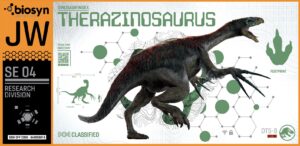
By the mid-1970s the arms, a couple ribs, and one foot of this dinosaur were identified from the Nemegt Formation. The placement of therizinosaurs on the theropod family tree was determined by Altangerel Perle in 1982, as he compared their skeletal remains to that of the genus Segnosaurus. Deciding that these animals must be closely related, Perle classified them together. The taxonomy of therizinosaurs is now fairly well-accepted among paleontologists, with many more of these strange animals being discovered in the ensuing decades, but few remains of Therizinosaurus itself have been found. What is known is that it was one of the last therizinosaurs to evolve, and it reached huge sizes comparable to the biggest carnivorous theropods.
This species has been brought back from extinction in recent history by Biosyn Genetics, a bioengineering company which had developed de-extinction techniques by the late 2010s. Using ancient DNA sourced from amber and other fossils, Biosyn was able to use cloning technology to re-create Therizinosaurus for genetic research. Biosyn was not the first company to obtain this animal’s DNA, however; International Genetic Technologies had reconstructed the Therizinosaurus genome by 2009.
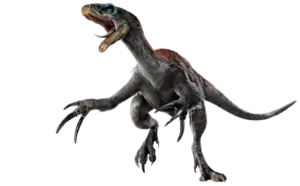 Description
Description
Therizinosaurus is a huge theropod, growing from 13 to 19.6 feet (4 to 6 meters) in height when fully grown and measuring from thirty to forty feet (nine to twelve meters) long. It may weigh as much as three to six tons (2721.6 to 5443.1 kilograms). With these dimensions, a mature and healthy Therizinosaurus may approach the size of a Tyrannosaurus rex. In other ways, though, the Therizinosaurus is the polar opposite of a Tyrannosaurus; rather than massive crushing jaws, it has a relatively small head and long neck, and instead of tiny arms, it has lengthy arms with enormous claws. Fossils of this dinosaur are sparse, so before it was cloned by Biosyn Genetics, paleontologists had to draw conclusions about its anatomy from close relatives. All therizinosaurs have proportionally small heads and toothless beaks, though there are small triangular teeth farther back in the jaws. The skull of Biosyn’s Therizinosaurus is somewhat boxy in shape, but elongated. The jaws are fairly weak, but the tongue is mobile and muscular; it is long, pointed, and pinkish in color. Its eyes are fairly large and possess orange sclerae and vertical slit pupils. These may aid it in judging distance among vertical objects like trees, but this is far more common in small animals; they may be an evolutionary leftover harking back to the therizinosaurs’ smaller ancestors. Like most theropods it has a nictitating membrane originating from the medial canthus of each eye, which is used to protect the eye and remove debris. This dinosaur has excellent hearing, able to distinguish depth using sound about as well as modern oilbirds. Its sense of smell is also quite good, as is its sense of balance; these are known from fossil evidence as well as live specimens.
Its lengthy neck (7.2 feet, or 2.2 meters, long) connects to strong shoulders, the base for its impressive 7.9-foot (2.4-meter) arms. They are long enough that the tips of its claws can easily touch the ground if it bends over slightly, but much of this length is the claws themselves: the longest of any known animal, they reach nearly a meter (three feet) in length. It has three fingers, each tipped with such a gigantic claw. Unlike many of its therizinosaur relatives, the claws of Therizinosaurus are mostly straight, flattened from side to side, and sharply curved at the tips. The hands and arms on the whole are robust and strong, with powerful deltoid and bicep muscles. The vertebral column is heavily pneumatized, filled with air sacs, to aid in reducing its weight. The pelvis is robust and ophistopubic, meaning it is oriented backwards. It has a rather short tail.

A biped, Therizinosaurus strides upon legs that measure around 9.8 feet (three meters) in length and are also quite strong. They must be, in order to support the dinosaur’s multi-ton weight; much of that weight is in its belly, even though Biosyn’s specimens are leaner than their ancestors likely were. It is unknown if this is dietary or genetic in nature. In any case, the feet supporting this huge animal are tetradactyl, meaning they have four toes, the first (innermost) of which is the smallest. However, unlike in many theropods, it is not a dewclaw, but can actually be balanced upon. The other toes are longer. All of the toes bear claws, which are flattened from side to side and quite sharp, though not especially long. Therizinosaur feet are unique among theropods for the arrangement of their toes. They have a plantigrade gait, similar to a crocodile.
Much of this animal’s body has a coat of hair-like sparse feathers, which are built around a central vane and have a recognizable oily iridescence. Most of these feathers are rusty reddish, forming a stripe down the animal’s back that is framed by the light gray feathers lower on its body. The scaly underparts, including its belly, legs, the insides of its arms, and the underside of its tail, are also light gray in color. Its palms are slightly yellowish, and the beak is distinctly lighter yellow. The feathers of its head are darker gray, while its nasal ridges and eye orbits have a splash of color: a brightly teal highlight on either side, contrasting with the shady colors on the rest of its body.
Growth
Little is known about the ontogeny of therizinosaurs, but in many theropods, juveniles are able to keep up with adults at a young age and grow somewhat rapidly. In at least the Biosyn specimens, adulthood is reached after only a few years; an adult in early 2022 was likely not bred until 2018 or later.
Sexual Dimorphism
At this time, sexual dimorphism is unknown in Therizinosaurus due to a lack of specimens. Only the female has been confirmed.
Habitat
Preferred Habitat
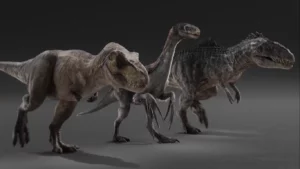
In its native Cretaceous environments, Therizinosaurus lived on alluvial plains, flat regions created by the deposition of sediment by rivers. It was a temperate mesic habitat, with distinct dry and wet seasons; monsoons are believed to have struck during the wet season, fueling the meandering rivers that defined the environment. In between the rivers were regions of thick woodland, including Araucaria trees. Neighboring areas were far more arid, with the Nemegt Formation’s wetlands and lakes forming a kind of oasis in a land where water was scarce. Therizinosaurus is well-equipped for survival in thickly wooded and humid places.
It will cut undergrowth using its claws, leaving semicircular piles of sliced vegetation in its territory. While it can cut young trees, larger ones are instead scratched or gouged, serving as a marker of the animal’s territorial boundaries. Animals that intrude upon it are often left with similar gouges in their flesh.
Muertes Archipelago
There is no evidence that Therizinosaurus was ever bred in the Muertes Archipelago.
Isla Nublar
While International Genetic Technologies did obtain Therizinosaurus DNA prior to 2009, there is no evidence that they ever cloned this animal. As of such it probably never lived on Isla Nublar.
Mantah Corp Island
InGen’s rival Mantah Corporation illegally obtained a number of specimens from InGen properties in the early 2010s, constructing their own facility on Mantah Corp Island to the southeast of Isla Nublar. However, if they obtained Therizinosaurus DNA, there is no evidence they cloned this animal.
Biosyn Genetics Sanctuary
The first entity known to have cloned Therizinosaurus was Biosyn Genetics, which operated a sanctuary in Biosyn Valley among Italy’s Dolomite Mountains until 2022. At least one Therizinosaurus, a female, was bred there sometime between 2018 and 2022; she inhabited the wetter southwestern parts of the valley a mile or so east of the hydroelectric dam, in between the foothills of the Dolomites and the waterways of the central valley. This animal was identifiable by its blindness, having developed impenetrable cataracts over both eyes.
During an effort by Biosyn’s CEO Lewis Dodgson to cover up evidence of his own crimes in early 2022, the valley was accidentally subject to a massive wildfire necessitating an evacuation. All of the animals were remotely herded via their neural implants into emergency containment through the courtyard in Biosyn’s headquarters. The Therizinosaurus was among the last dinosaurs to arrive, surviving a fight with the valley’s Giganotosaurus in which the predator was killed. Despite an older female Tyrannosaurus also being involved with the incident, the Therizinosaurus is believed to have survived, though she lost most of the third finger on her left hand to the Giganotosaurus.
With the blaze extinguished by rainfall by morning, the damaged valley was able to accept its inhabitants back home. The Therizinosaurus, presumably, has returned to her waterlogged territory in the southwest of the valley. It is unknown if she is the only one of her kind, or if others have been introduced. Biosyn Valley is now overseen by the United Nations, with Biosyn losing its exclusive access to the valley and its animals after the incident.
Black market
This dinosaur seems to be rare, and has yet to be reported on the black market. Being so large makes it difficult to smuggle, so poachers would be more likely to target juveniles. Young animals captured illegally and traded across international borders would probably pass through the Amber Clave night market at some point, a hub of illegal trade operated at various locations in Malta.
Wild populations
Originally this animal lived in Asia, in a seasonal wetland located where the Gobi Desert is now. Since few fossils have been found, little is known about how common it was or for how long its kind persisted on Earth; it lived around seventy million years ago. The reasons for its extinction, like with many prehistoric species, is not fully known. Most likely, sudden changes to its environment left it unable to adapt, and it died out. In the modern day, scientists were able to recover fossils containing fragments of DNA from this theropod, painstakingly rebuilding its genome and restoring it to life. The modern version is believed to be fairly faithful to its ancestor, but genetic modification is an unavoidable aspect of the de-extinction process, so modern Therizinosaurus can be expected to differ from those that lived millions of years ago.
The Department of Prehistoric Wildlife is aware of Therizinosaurus living in the wild, but no specific locations have yet been reported. Presumably this animal’s rarity and territorial nature make it seldom seen. It could theoretically adapt to a number of freshwater environments around the world today; paleontologists believe that the Okavango Delta in Botswana, for example, is very similar to its habitat in the Cretaceous period.
Behavior and Ecology
Activity Patterns
This dinosaur appears to be diurnal, active mainly during the daytime. Around midday it will patrol its territory and feed. It is only active at night when it is disturbed. It has vertical slit pupils, but rather than being an adaptation for nighttime, they more likely aid it in judging distance among vertically-standing trees. They may even just be an evolutionary remnant from its smaller ancestors.
Diet and Feeding Behavior
Therizinosaurus is chiefly herbivorous, though it may sometimes feed upon fish in the wetlands it inhabits. Whatever it chooses to eat, its claws are used to harvest; they grow to three feet in length and have sharply hooked tips, used for grabbing items and pulling them closer. Most often, it will hook its claws over branches and foliage, drawing its food to its beaked mouth where it crops off edible parts to swallow. Its tongue is also muscular and can be used to feel around for leaves, berries, and other plant parts it eats.
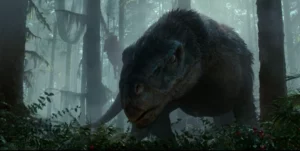
Its pelvic girdle is designed for sitting, so when it is relaxed enough, it may sit down to feed. Its hands can be used to push itself back to its feet. Much of its plant diet comes from shrubs and trees; since it is very tall, it can reach most branches. It also feeds from low-growing plant life, and has been known to eat the midland hawthorn (Crataegus laevigata) and various ferns. While its clawed fingers are not precision implements, they are very efficient at raking up large amounts of leaves to eat. It has plenty of options for harvesting food, from pulling down branches to pushing aside clumps of foliage to simply shoveling large amounts of leaf litter into its mouth. Although it is highly territorial and may kill rivals in defense of its food supplies, it does not scavenge the carcasses of animals it kills. The only meat it is known to eat comes from small to medium-sized freshwater fish.
Biosyn’s Therizinosaurus is slimmer than its ancestor, though whether this is due to diet or genetics is unknown. It was originally quite a fat animal, and even the modern version is still heavy, with much of its weight (up to six tons) consisting of its belly. Most of its food-processing takes place here. Unlike in carnivorous theropods, Therizinosaurus has few teeth, and what teeth it has are small; it also has a weak bite force.
Jurassic World: Evolution 2 portrays it as feeding upon foliage, mainly obtained from low-growing plants such as vines and climbers.
Social Behavior
Not much is known about the social behaviors of Therizinosaurus. It is a surly animal that prefers to live alone, and is highly defensive of its food sources. Most of its coloration is also subdued, with just the blue highlights on its face giving it some vibrancy, so it does not seem to be colored for visual displaying. It may be that this animal only comes together for reproduction, otherwise keeping to itself.
In the game Jurassic World: Evolution 2, while they are still portrayed as mostly solitary animals, Therizinosaurus in the same social group will preen and groom each other.
Reproduction
Therizinosaurus, like all dinosaurs, lays eggs; while none have been seen from live specimens and fossil eggs cannot usually be identified to the genus level, eggs of closely-related animals are well known. Therizinosaur eggs are large, and unlike the ovular eggs of many theropods, they are spherical. Though this dinosaur is quite different from other theropods, some of its reproductive habits are probably similar. It has a cloaca, where its reproductive organs are located, and probably engages in some manner of courtship before mating as most theropods do. As its long claws are the key to its survival, therizinosaurs with larger claws are probably more attractive to mates. The gouges and slashes left in tree trunks around its territory may function as a way to advertise to mates.
Since juveniles have not been observed directly, not much is known about their early lives. Most theropods lay eggs in ground nests, with larger dinosaurs’ eggs usually having longer incubation periods (for giants like Therizinosaurus, a months-long incubation would not be unheard of). Nesting material is probably easy to come by for this animal, whose forest habitat provides plenty of soft leafy matter that the claws would efficiently cut down to size. Fossils of related animal nests are round structures, containing eight eggs. These fossils suggest that therizinosaurs nest in large groups for protection against predators and use different nesting sites from one year to the next, but also that their juveniles are precocial; that is, they can walk almost as soon as they hatch, and so can feed themselves. Most dinosaurs, even unfriendly ones, provide parental care to their offspring; adult Therizinosaurus likely protect their young while they are still small enough to be threatened by predators. If their growth rates are similar to other theropods, or to large herbivorous dinosaurs, they probably reach maturity in around a decade.
Communication
Therizinosaurus is generally a loner, so its vocalizations are largely used for intimidating rivals during territorial defense. It can be heard making guttural clucks, growls, and sometimes high-pitched screams and roars. One individual has been observed generating lower-pitched booming clicks, which are believed to be not for communication but as a form of echolocation; by listening for the echoes it can determine how far away objects are.

In addition to its vocalizations, some of the behaviors exhibited by this dinosaur may be a form of communication. As it harvests food from its forested habitat, it leaves behind semicircular piles of cut vegetation and leaves deep slashes in the bark and wood of trees. Other therizinosaurs would recognize these signs and know that they were approaching the territory of one of their own kind. Whether personal information, such as sex, can be conveyed through these visual signs is not currently known.
Ecological Interactions
Therizinosaurus are not just solitary among their own kind; they do not enjoy the company of other animals either, and while they do not seek out confrontation, they are perpetually prepared for it. When they encounter another animal, they will not hesitate to drive it away, often to lethal effect; the claws can be used to swat at smaller enemies and cause fatal lacerations. However, it does not eat its victims, as it mostly feeds on plants. This can benefit any carnivores that are brave enough to intrude upon the therizinosaur’s territory to snatch a free meal. Both Tyrannosaurus and Giganotosaurus have been observed engaging in this behavior.
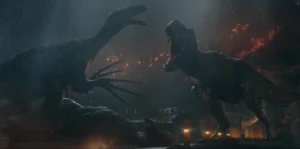
While many large herbivores plow down areas of woodland as they feed, Therizinosaurus tends to leave its forests intact, pulling down branches to feed and browsing on low-growing shrubs but not usually tearing down adult trees. Saplings, as well as other young or small plant life, may fall victim to its claws. Injuries to larger trees may occur when it scratches its claws on the bark. For the most part, Therizinosaurus benefits forests and benefits from them, not just feeding upon the plants but using larger trees to hide from enemies. One Therizinosaurus will defend a whole area of forest from rivals, so that part of the woods will have fewer herbivores grazing and browsing in it. This allows more plants to grow unhindered, and the Therizinosaurus then has a wider selection of food available.
It does not tolerate even human-sized herbivores in its territory. In fact, the only animals it will tolerate at all are those small enough to escape its notice; a single deer is even too large. Flying creatures, such as Pteranodon, may live in the same territory, but they should keep on the wing while the Therizinosaurus is around. This dinosaur lives near rivers, lakes, and swamps, so it often encounters aquatic life; it has been known to feed on freshwater fish. When it encounters a larger threat, it will make aggressive displays by screeching and showing its huge claws. Although the claws are built more for feeding than fighting, when pressured to do so a Therizinosaurus will not hesitate to slash at a predator. If this does not kill its attacker, it will at least give the carnivore good reason not to try and prey on this animal again.
Biting insects and other pests are known to target all manner of animals, including dinosaurs, and Therizinosaurus is probably host to various parasites that it picks up from its environment. In particular, mosquitoes in prehistoric times are known to have fed on the blood of dinosaurs and probably do the same today. InGen, and later Biosyn, may have obtained the DNA of this animal from parasites preserved in Mongolian amber.
Cultural Significance
Symbolism
For a long time, the true appearance of Therizinosaurus was poorly known. It was not until scientists realized it was related to the better-understood Segnosaurus that a clear image of its body started to take shape. Even now, only a few bones have been found, and so until it was brought back from extinction, only its arms, one leg, and a few ribs could be reconstructed with complete confidence. Speculation about its lifestyle and biology were varied, making Therizinosaurus historically one of the more mysterious dinosaurs. It gives its name to the Therizinosauridae family; before its identity was understood, the therizinosaurs were called segnosaurs.
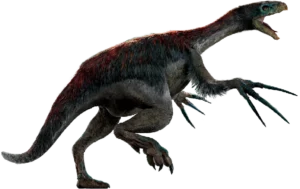
Its mystery has long captivated artists, who imagined what sort of creature it might be. Today, since its relatives paint a decently clear picture of what it was probably like in life, it makes for a great example of convergent evolution. Scientists often compare it to other animals, including mammals such as chalicotheres, gorillas, giant anteaters, and ground sloths. While dinosaurs and mammals are not closely related, Therizinosaurus exists in a similar ecological niche and has some anatomical similarities. Such an unusual animal is not only interesting to depict, it holds an abundance of features that can be used to teach about many evolutionary concepts.
In Captivity
So far no efforts at keeping this animal in traditional captivity have been reported; the only specimen whose location is known lives within the Biosyn Genetics Sanctuary, where it is monitored but generally not controlled by staff. The main challenge to keeping it would be its territorial behavior: it does not tolerate humans in its territory at all, nor most other animals. This would make it hard to perform maintenance on its habitat or give it medical care. Aside from this, its habitat needs include woodland and wetland environments, with plenty to feed upon all the time. As a solitary animal, it should be possible to keep it alone.
Science
This animal has a confused history in paleontology since only fragmentary remains have ever been found, but it played a significant role in demonstrating where therizinosaurs lie in the theropod evolutionary lineage. It is considered a strange example of convergent evolution, with carnivorous theropods evolving into herbivorous ones and developing traits similar to herbivorous mammals. Therizinosaurus, as one of the last of its kind to evolve, appears to have been particularly well-adapted to this way of life. Understanding this animal has helped paleontologists realize the diverse strange forms that dinosaurs were taking on by the time they became extinct.
In the modern age, this animal’s genetics have come to be a subject of scientific interest. In 2009, Dr. Henry Wu of InGen utilized genes from Therizinosaurus while engineering the Indominus rex, an artificial life form constructed by hybridizing numerous other species on the genetic level. Later, the animal itself was brought to life by Biosyn, and is now studied for biomedical science. Extinct organisms may yield pharmaceuticals which are unheard of in modern biology, making them invaluable to medical research.
Politics
The first cloned Therizinosaurus hatched considerably after the debate around de-extinct animal rights had hit its first flashpoint with the Mount Sibo controversy, but this animal had already been involved behind the scenes in another serious ethical debate. InGen geneticist Henry Wu had used it among several other animal species as a donor for the Indominus rex genome, a foray into bioengineering for explicitly military purposes. The legality of this kind of genetic engineering is inherently murky as advances in science come much faster than changes in law, but the creation of the Indominus has opened an ethical can of worms and become one of the major debates of the Genetic Age.
Resources
Even before it was cloned by Biosyn Genetics, this dinosaur had served a purpose to InGen, the first company to successfully perform de-extinction. Advances in gene splicing techniques developed out of InGen’s earlier accomplishments, leading to the creation of the artificial species Indominus rex by Henry Wu. This animal was engineered through artificial hybridogenesis, splicing genes from various other animals into a template genome. Therizinosaurus, with its massive and powerful arms, was among the species selected by Dr. Wu as a gene donor. These intimidating offensive capabilities were implemented into the Indominus rex. The living animal was not cloned at the time Jurassic World was operational, so it has never been used as a park exhibit.
In more recent times, the applications of Therizinosaurus in medicine have come to light. While its earlier contributions to genetic science were important (being the first therizinosaur to have its genome reconstructed, as well as the first ever cloned), its biology has been studied by Biosyn for any unique pharmaceutical properties it may yield. While little information is available so far on what was found, Biosyn believes that ancient biopharmaceuticals could potentially be used for the treatment of myriad diseases affecting people today.
Safety
While its rarity and nature as a reclusive animal makes a Therizinosaurus attack unlikely, all animals are dangerous under the right circumstances, and it takes little to anger this dinosaur in particular. Normally it lives in densely wooded areas with sources of fresh water nearby, feeding on local plant life and generally avoiding other creatures. It will not seek you out, so a conflict is more likely to arise from your accidental intrusion into its territory. If you notice signs of therizinosaur activity, such as large gashes in tree trunks or cut and torn foliage on the ground, you should immediately leave the area.
Fortunately you may hear this dinosaur before you see it. Since they have few natural predators, they can afford to be loud, which helps them warn away rivals and enemies. Conversely, they might interpret other creatures’ loud noises as a sign of aggression, so do not try and scare them off this way. Some animals may flee if you seem bigger and louder than they are, but this will not work with Therizinosaurus. Instead try to leave the area quietly and calmly, drawing as little attention to yourself as you can. Remain downwind, as its sense of smell is very good.
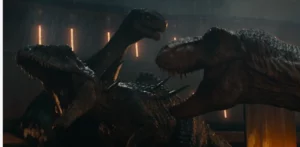
Should you encounter the animal itself, you still have hope of escaping it so long as you are agile. The bulky size of this dinosaur combined with its dense woodland habitat mean that it is not exceptionally maneuverable and the average human can move faster than it. Place thick, defensive barriers between yourself and the animal, bearing in mind that its claws are efficient at removing weaker obstacles. Vehicles are not as effective a defense against it unless you are actively driving away. As you make your retreat, keep its claws in view and stay out of their sweeping range; a swipe from one of its hands can kill an animal larger than a human. Do not attempt playing dead either. Therizinosaurus does not eat meat aside from the occasional fish, but it is extremely territorial and may check to see whether you are really dead (and correct the situation should it realize you are alive). Once you have left its territory, it is unlikely to follow you, but you should report the sighting to the Department of Prehistoric Wildlife and your local animal control authorities. The experts will be able to more effectively collect the animal and transport it to a sanctuary.
Behind the Scenes
The inclusion of Therizinosaurus as a component of the Indominus rex in 2015’s Jurassic World was suggested by paleontological consultant Jack Horner, who believed it was the best match for the huge arms of the Indominus.
Creature design on the Therizinosaurus focused heavily on what kind of feathers it would possess, with science suggesting it would have more primitive hair-like feathers covering parts of its body. The Therizinosaurus seems to have been designed for Jurassic World Dominion with two ideas in mind: to counter the argument that feathered dinosaurs cannot be frightening, and to offset the films’ usual depiction of herbivorous animals as harmless and friendly. The result was the aggressive territoriality of the animal introduced in the 2022 film.
Notable Individuals
Blind Therizinosaurus – female bred by Biosyn Genetics

